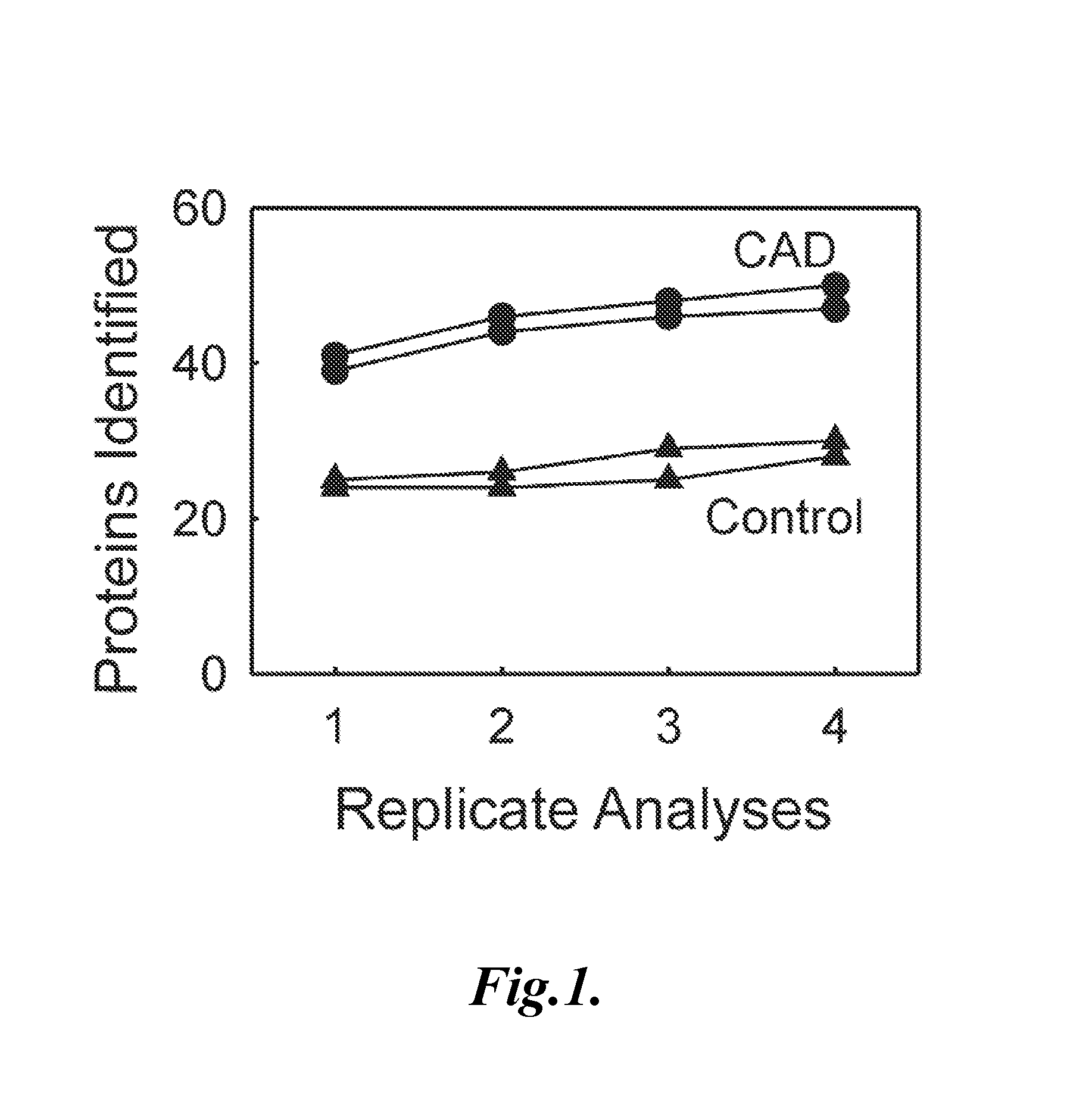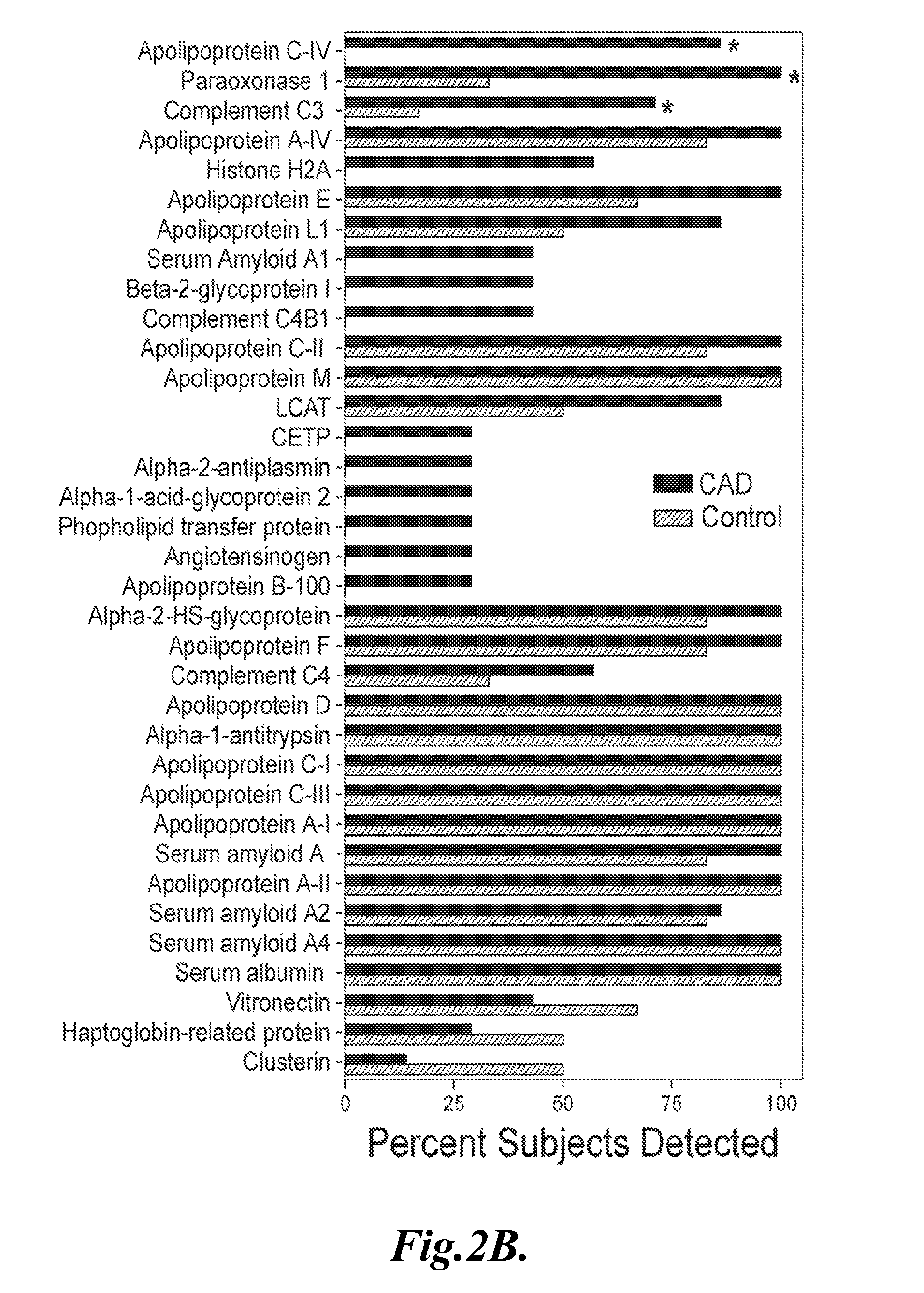Lipoprotein-associated markers for cardiovascular disease
a technology of lipoprotein and cardiovascular disease, applied in the field of methods, reagents and kits for diagnosing cardiovascular disease in subjects, can solve the problems of cardiovascular disease remaining a leading cause of morbidity and mortality in developed countries, and cardiac disease is a leading cause of morbidity and mortality
- Summary
- Abstract
- Description
- Claims
- Application Information
AI Technical Summary
Benefits of technology
Problems solved by technology
Method used
Image
Examples
example 1
[0072]This example demonstrates the validation of a method used to identify HDL-associated protein biomarkers that correlate with cardiovascular disease, in accordance with one embodiment of the present invention.
[0073]Rationale: A proteomic approach was used to directly measure the proteins associated with HDL, also referred to as “shotgun proteomics.” In order to minimize potential contamination with LDL, the lipoprotein's dense subfraction, HDL3, was isolated and analyzed.
[0074]Sample isolation and preparation: All protocols involving human subjects were approved by the Human Studies Committees at the University of Washington and Wake Forest University. Blood samples were collected from healthy adult males and from male patients with CVD after an overnight fast. Blood samples were anticoagulated with EDTA.
[0075]HDL isolation: HDL (d=about 1.06 to about 1.21 g / mL) and HDL3 (d=about 1.11 to about 1.21 g / mL) were isolated from the blood samples by sequential density ultracentrifliga...
example 2
[0080]This example demonstrates that shotgun proteomics may be used to reproducibly identify proteins associated with HDL from blood, and that the HDL from healthy subjects and from subjects with established CVD carry different associated protein cargo.
[0081]Methods: Using sequential density gradient ultracentrifugation, HDL (d=about 1.060 to about 1.21 g / mL) was isolated from the blood plasma of two apparently healthy men and from two men with established CVD, using the methods described in EXAMPLE 1. HDL proteins in each sample were precipitated with trichloroacetic acid, digested with trypsin and desalted. Each digest was then subjected to four μLC-ESI-MS / MS analyses with an ion trap instrument as described in EXAMPLE 1. Proteins were identified as described in EXAMPLE 1.
[0082]Results: FIG. 1 shows the results of the four separate analyses of the two samples taken from control individuals and two samples taken from individuals with CVD. As shown in FIG. 1, the μLC-ESI-MS / MS analy...
example 3
[0084]This example describes the identification of particular HDL-associated proteins present in the HDL3 subfraction isolated from normal control subjects and subjects with CVD.
[0085]Rationale: In order to further investigate the protein composition of HDL in control subjects and subjects with CVD, the HDL3 subfraction was isolated to minimize potential contamination with LDL.
[0086]Methods:
[0087]Subjects Used in the Study:
[0088]HDL3 was isolated from the blood samples of 7 men with established CVD and from blood samples obtained from 6 apparently healthy age-matched control subjects mean age ±SD, 54±7, and 54±14 years, respectively.
[0089]The CVD patients were newly diagnosed, as documented by clinical symptoms consistent with angina and q waves on their EKG, or at least one stenotic lesion [>50%] on coronary angiography. None of the subjects smoked cigarettes, nor did they have liver or renal disease. The subjects did not receive any lipid-lowering medications for at least 8 weeks ...
PUM
| Property | Measurement | Unit |
|---|---|---|
| density | aaaaa | aaaaa |
| density | aaaaa | aaaaa |
| density | aaaaa | aaaaa |
Abstract
Description
Claims
Application Information
 Login to View More
Login to View More - R&D
- Intellectual Property
- Life Sciences
- Materials
- Tech Scout
- Unparalleled Data Quality
- Higher Quality Content
- 60% Fewer Hallucinations
Browse by: Latest US Patents, China's latest patents, Technical Efficacy Thesaurus, Application Domain, Technology Topic, Popular Technical Reports.
© 2025 PatSnap. All rights reserved.Legal|Privacy policy|Modern Slavery Act Transparency Statement|Sitemap|About US| Contact US: help@patsnap.com



